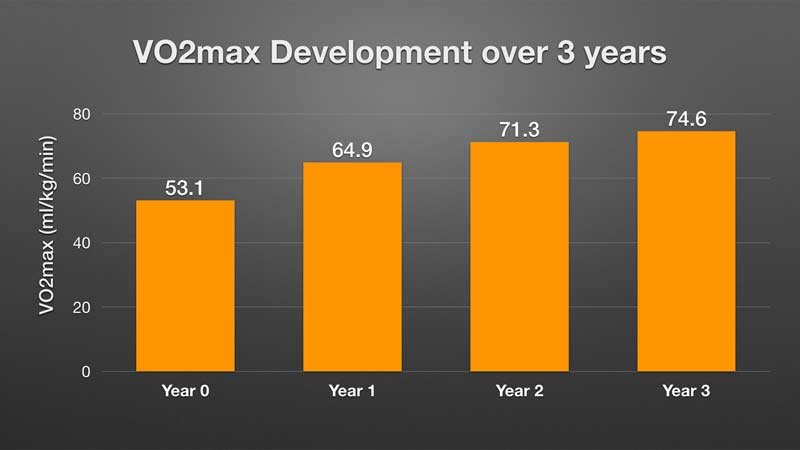Cardio fitness data has transformed how we track, monitor, and improve our health. With the advent of wearable devices, understanding key metrics like steps taken, heart rate, calories burned, and even blood oxygen levels has become a part of daily life. Among these metrics, VO2 Max stands out as a crucial measure of cardiorespiratory fitness and life expectancy. In this article, we’ll explore these metrics in depth, emphasizing the importance of VO2 Max and how it shapes overall health.

Key Metrics Provided by Wearable Devices
Wearable fitness devices have redefined personal health monitoring, offering real-time insights into physical activity and overall well-being. Below are some of the most important metrics tracked by these devices.
Steps and Heart Rate
Wearable devices count the steps you take throughout the day, providing a measure of physical activity. This metric helps you stay accountable and ensures you meet your movement goals.
Heart rate monitoring is another essential feature. Devices measure your resting heart rate and fluctuations during exercise, offering insights into cardiovascular health. A lower resting heart rate often indicates higher cardiovascular efficiency, while elevated heart rates during workouts suggest you’re pushing your aerobic capacity.
Calories Burned
Tracking calories burned helps you understand how much energy you expend during various activities. Wearables calculate this based on your heart rate, steps, and other metrics, giving a clear picture of your energy balance—a critical factor for weight management.
Blood Oxygen Levels
Modern wearables include SpO2 sensors that measure blood oxygen saturation. This metric is crucial for understanding how effectively your body distributes oxygen during rest and activity, which is vital for physical performance and recovery.
Why VO2 Max Is Crucial for Cardiorespiratory Fitness
While the above metrics are valuable, VO2 Max is considered the gold standard for assessing cardiorespiratory fitness. It measures the maximum amount of oxygen your body can utilize during intense exercise, reflecting your cardiovascular and respiratory systems’ efficiency.
How VO2 Max Is Measured
VO2 Max can be assessed in a lab setting through a graded exercise test where oxygen consumption is directly measured. However, most wearable devices estimate VO2 Max using algorithms that combine heart rate, activity intensity, and personal data like age, weight, and fitness level. While not as precise as lab tests, these estimates offer a reliable gauge for tracking improvements over time.
VO2 Max and Life Expectancy
Studies link higher VO2 Max levels to better health outcomes, including reduced risks of chronic diseases like heart disease, diabetes, and hypertension. A higher VO2 Max is also associated with increased longevity, making it one of the most important fitness metrics.

How to Improve VO2 Max with Wearable Devices
Improving VO2 Max requires consistent effort and structured training. Wearable devices can play a pivotal role in guiding your progress.
1. Engage in Aerobic Activities
Activities like running, cycling, and swimming are effective for boosting VO2 Max. Use your wearable to monitor heart rate zones and maintain moderate to high-intensity efforts during these activities. You might also want to consider the best cardio machines for optimal calorie burning, which can be beneficial if you prefer indoor workouts. For more comprehensive fitness advice, including expert tips on various exercise routines, you can explore resources from ramivault.com.
2. Interval Training
High-intensity interval training (HIIT) is one of the fastest ways to improve VO2 Max. Wearable devices can help track your heart rate during intense bursts and recovery periods, ensuring you’re working at optimal intensity.
3. Track and Adjust
Wearable devices often provide fitness trends and performance reports. Use this data to identify plateaus and adjust your routine, incorporating varied exercises to continue improving.
Benefits of Monitoring Cardio Fitness Data
Understanding and utilizing cardio fitness data leads to numerous benefits, from improving athletic performance to enhancing everyday health. Here’s why you should take these metrics seriously.
1. Personalized Training
Wearable devices offer personalized recommendations based on your unique data. This helps tailor workouts to meet specific goals, whether it’s weight loss, endurance building, or general health improvement.
2. Early Detection of Health Issues
Metrics like resting heart rate and blood oxygen levels can reveal potential health problems early, allowing timely intervention.
3. Motivation and Accountability
Seeing your progress in numbers is a powerful motivator. Whether it’s a streak of meeting step goals or an improved VO2 Max, the data keeps you accountable and focused.
Conclusion
Cardio fitness data is more than just numbers—it’s a roadmap to better health and a longer life. By understanding key metrics like steps, heart rate, calories burned, and especially VO2 Max, you can take charge of your fitness journey. Wearable devices make this easier than ever, providing actionable insights to help you stay on track and reach your health goals. So, why wait? Start leveraging your fitness data today and work towards a healthier tomorrow.
FAQs
1. What is VO2 Max, and why is it important?
VO2 Max is the maximum amount of oxygen your body can utilize during intense exercise. It’s a key indicator of cardiorespiratory fitness and is linked to better health and longevity.
2. Can wearable devices accurately measure VO2 Max?
While wearables provide estimates rather than precise measurements, they’re reliable for tracking improvements over time and guiding fitness plans.
3. How can I improve my VO2 Max?
Engaging in aerobic exercises like running, interval training, and consistent physical activity are the best ways to improve VO2 Max.
4. Are wearable devices worth the investment for fitness tracking?
Yes, they provide valuable insights into your physical activity, health metrics, and progress, making them a helpful tool for achieving fitness goals.
5. Is blood oxygen level monitoring necessary for fitness?
While not essential for everyone, it’s beneficial for athletes and individuals with specific health conditions, as it indicates how efficiently your body distributes oxygen.




















